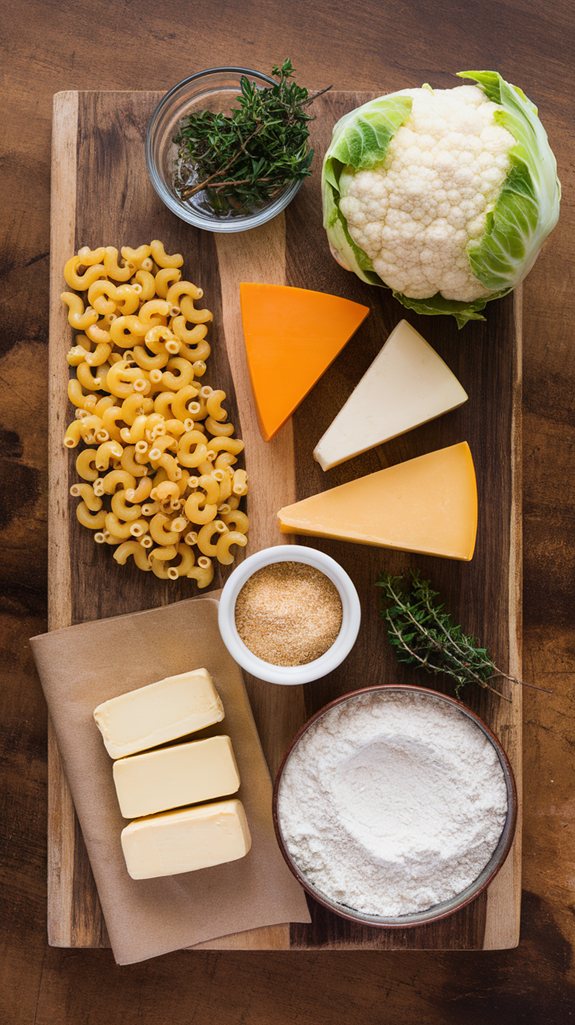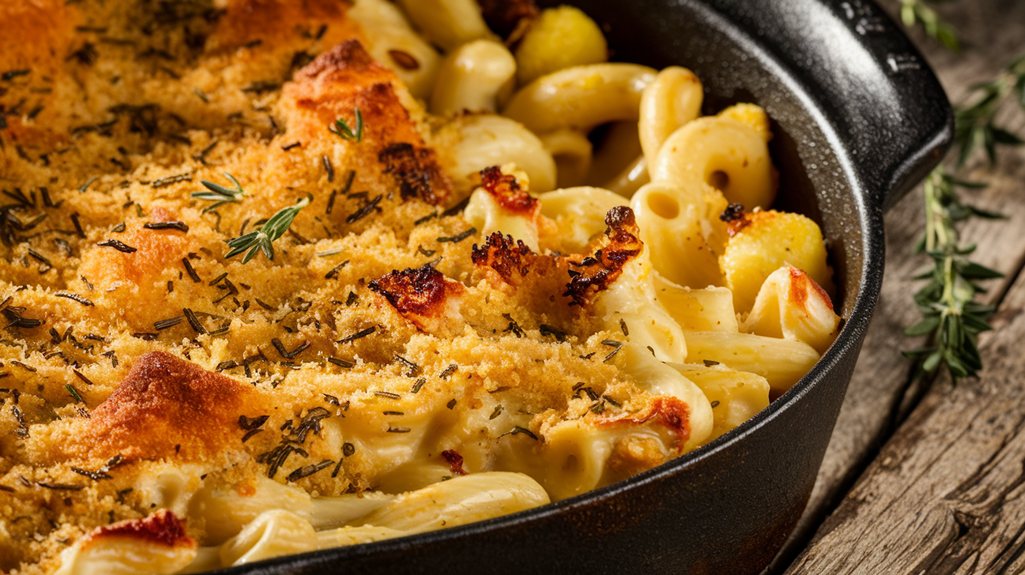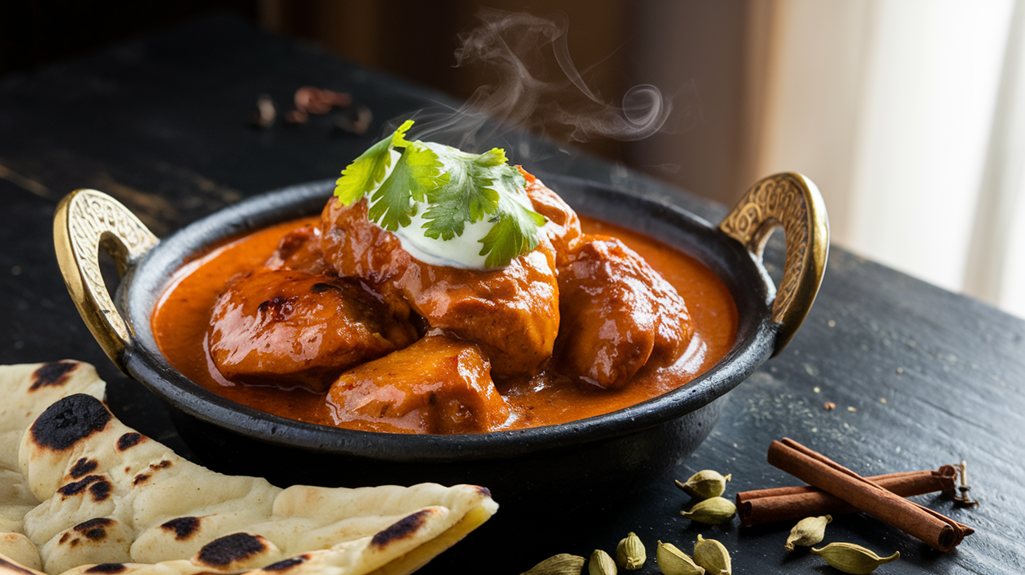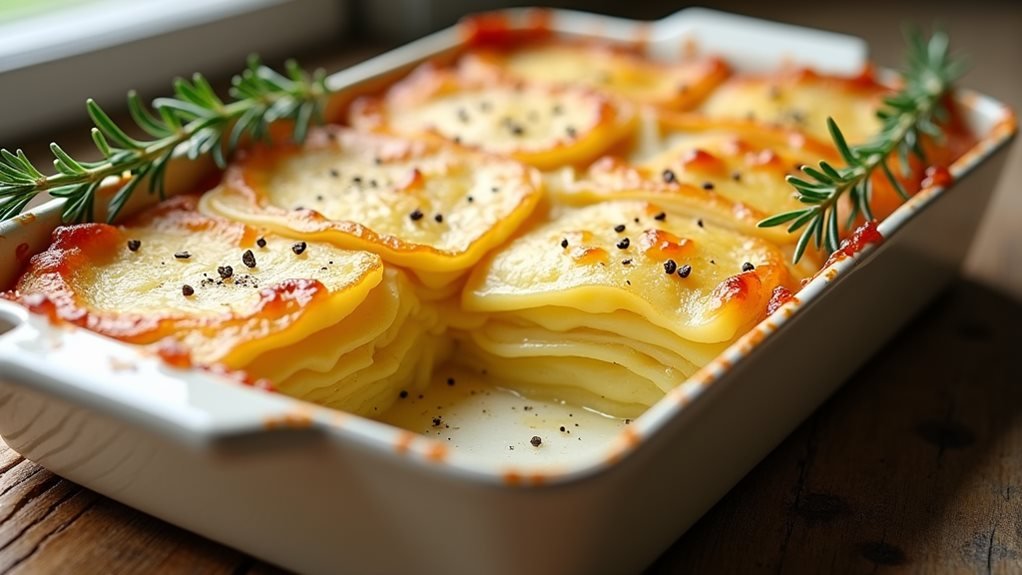You're about to uncover why Gordon Ramsay's mac and cheese has become a legendary comfort dish that's captured hearts worldwide. While the classic version dates back to ancient Rome's simple pasta and cheese combinations, Ramsay's modern interpretation adds unexpected elements like cauliflower and artisanal English cheeses. His technique transforms basic ingredients into a luxurious meal that'll make you question everything you thought you knew about this humble dish.
Origin in Ancient Rome
While many people associate mac and cheese with modern American comfort food, this beloved dish actually traces its roots back to ancient Rome.
You'll find records of cheesy dishes made with pasta in Roman cookbooks dating back to the 1st century AD. The Romans created a dish called "de lasanis," which combined sheets of pasta with cheese sauce – an early ancestor of today's creamy mac and cheese.
Much like how raw eggs create creamy sauces in traditional Italian dishes, adding heat at the right moment was crucial even in ancient preparations.
As trade routes expanded, this concept of combining pasta and cheese spread throughout Europe.
Similar to Gordon Ramsay's technique, this dish has evolved through centuries of culinary innovation.
The pursuit of culinary perfection seen in Hell's Kitchen winners has helped elevate classic dishes like mac and cheese to new heights.
Mac and Cheese History

Mac and cheese traces its roots back to 14th century Italy, where the primary recorded recipe appeared in a cookbook called "Liber de Coquina." The dish made its way through European nobility before reaching American shores, where Thomas Jefferson significantly served it at state dinners after uncovering it during his time in France.
Gordon Ramsay's modern interpretation of this classic comfort food combines traditional elements with sophisticated additions. His version enhances the humble mac and cheese by incorporating cauliflower florets and a carefully selected blend of English cheeses, creating a dish that pays homage to its historical roots while meeting contemporary tastes. Like his famous Beef Wellington recipe, this dish demonstrates Ramsay's ability to elevate classic dishes with precise techniques and high-quality ingredients. Much like his Korean BBQ recommendations, this recipe reflects his diverse culinary expertise. Drawing from his experience running Restaurant Group ventures worldwide, Ramsay's mac and cheese showcases his talent for reinventing comfort classics.
- 1 pound elbow macaroni
- 1 medium cauliflower, cut into florets
- 4 tablespoons butter
- 4 tablespoons all-purpose flour
- 2 teaspoons English mustard powder
- 3 cups whole milk
- 1 cup sharp Cheddar cheese, grated
- 1 cup Lancashire cheese, grated
- 1 cup Cheshire cheese, grated
- 1 cup breadcrumbs
- 2 tablespoons fresh thyme leaves
- Salt and pepper to taste
- ¼ teaspoon cayenne pepper
Cook macaroni in salted water until al dente, adding cauliflower florets during the last 3 minutes.
Meanwhile, make the roux by melting butter in a saucepan, adding flour and mustard powder, and cooking for 2 minutes. Gradually whisk in milk until smooth and thickened. Stir in the cheeses until melted, then combine with drained pasta and cauliflower.
Transfer to a baking dish, top with breadcrumbs and thyme, and bake at 375°F for 20-25 minutes until golden brown.
For the best results, avoid pre-shredded cheese as it contains anti-caking agents that can affect the sauce's smoothness. The sauce should be slightly thinner than desired when combining with pasta, as it will continue to thicken during baking.
Testing the seasoning before baking is vital, as the flavors will concentrate during cooking. If the top browns too quickly, cover with foil to prevent burning while maintaining the creamy interior.
Regional Mac and Cheese
Beyond Gordon Ramsay's British-influenced version, regional variations of mac and cheese showcase distinct local flavors across different parts of the world.
You'll find Southern-style baked mac and cheese featuring extra sharp cheddar and a crusty top, while New England adds lobster for a seafood twist. In the Midwest, you'll encounter varieties using local cheese curds and cream. These comforting variations pair wonderfully with herb crusted lamb for an elevated dining experience.
International interpretations include Italian versions with mascarpone and fontina, creating ultra-creamy cheesy pasta dishes. Swiss variations incorporate Gruyère and Raclette for an Alpine touch. The best versions achieve a silky texture through frequent stirring technique, similar to making perfect risotto.
While these regional takes differ from Gordon Ramsay's mac and cheese recipe, they all share the fundamental comfort food appeal. Each region's unique ingredients and cooking methods reflect local tastes and traditions, from smoky bacon additions in the Southwest to truffle-infused versions in Pacific Northwest restaurants.
For an elevated seafood version, try incorporating tender meat from Ramsay's lobster risotto for a gourmet interpretation of this comfort classic.
Cheese Selection Guidelines
The right cheese selection forms the foundation of Gordon Ramsay's creamy mac and cheese recipe, with each variety contributing distinct flavors and melting properties.
You'll want to use a combination of sharp Cheddar for its bold taste, Lancashire for its buttery notes, and Cheshire for its crumbly texture and tangy finish.
When shopping for your gourmet creamy mac and cheese ingredients, look for aged Cheddar that's at least 12 months old.
Make sure your cheeses are at room temperature before adding them to your sauce, as this helps them melt more smoothly.
For the best results, grate your cheese fresh rather than buying pre-shredded varieties, which often contain anti-caking agents that can affect the sauce's texture and creaminess.
Just like with Damascus steel knives, proper care and maintenance of your cheese grater will ensure consistently smooth grating results.
Leftover Storage Options
Whether you've made a large batch or simply couldn't finish your delicious mac and cheese, proper storage will help maintain its creamy texture and rich flavor for several days.
To store your leftover creamy mac and cheese, let it cool completely at room temperature, then transfer it to an airtight container. You'll get the best results by placing it in the refrigerator within two hours of cooking.
Your baked pasta will stay fresh for 3-4 days when properly refrigerated.
For longer storage, you can freeze portions in freezer-safe containers for up to 3 months. When you're ready to enjoy it again, thaw your mac and cheese overnight in the refrigerator.
Reheat it gently in the microwave or oven, adding a splash of milk to restore its creamy consistency.
Mac and Cheese Reheating Tips
Properly reheating your stored mac and cheese makes a significant difference in restoring its original creamy texture and mouthwatering taste.
When using the microwave, add a splash of cream and a small pat of butter before heating in 30-second intervals, stirring between each round. You'll want to heat until it's just warmed through.
For oven reheating, transfer your mac and cheese to an oven-safe dish, add two tablespoons of cream and one tablespoon of butter, then cover with foil.
Heat at 350°F for 20-25 minutes, removing the foil for the last 5 minutes to restore some crispiness to the top. Remember to stir occasionally to guarantee even heating and prevent dry spots from forming.







